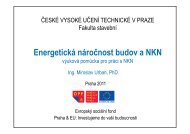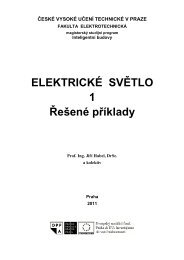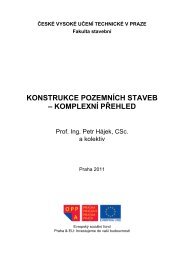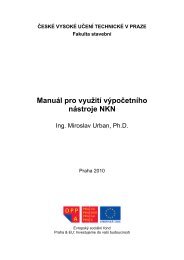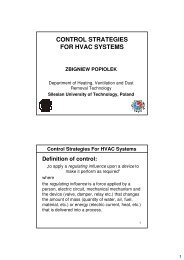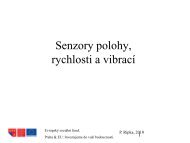Buses, Protocols and Systems for Home and Building Automation
Buses, Protocols and Systems for Home and Building Automation
Buses, Protocols and Systems for Home and Building Automation
You also want an ePaper? Increase the reach of your titles
YUMPU automatically turns print PDFs into web optimized ePapers that Google loves.
Evropský sociální fond. Praha & EU: Investujeme do vaší budoucnosti.<br />
choose from a very large portfolio of KNX devices (more than 7000) which are the most<br />
suitable with a function, price <strong>and</strong> design <strong>for</strong> their project. Product lines include not only<br />
actors, sensors or visualization panels, but also gateways, which are capable to interconnect<br />
the KNX system with all other building automation systems (e.g. BACnet, LON, EnOcean,<br />
DALI, OpenTherm).<br />
The system can be used <strong>for</strong> automation of every type <strong>and</strong> size of a building – from family<br />
houses to office complexes <strong>and</strong> airports. A classical <strong>and</strong> basic application of the protocol is a<br />
sophisticated light control, but today it covers all main tasks in building automation: energy<br />
management; energy consumption measure; HVAC control (using KNX meteo-station);<br />
advanced shutter <strong>and</strong> jalousie control; control of electronic devices; security <strong>and</strong> safety<br />
tasks…<br />
Similarly to other typical complex st<strong>and</strong>ardized protocol KNX uses more than one physical<br />
layer:<br />
- Twisted pair wiring (inherited from the BatiBUS <strong>and</strong> EIB)<br />
- Powerline networking 230V (inherited from the EIB <strong>and</strong> EHS)<br />
- Wireless KNX-RF (carrier frequency 868.3 MHz)<br />
- Infrared<br />
- Ethernet (KNXnet/IP)<br />
The most frequently used medium is a twisted pair (called TP1) with a speed of 9600 bit/s,<br />
which enables an interconnection of basic sensors <strong>and</strong> actors (field level). TP1 is also used as<br />
a power supply <strong>for</strong> sensors. Ethernet physical layer is used mainly <strong>for</strong> a connection of<br />
“higher” devices (automation level) like gateways, touch-panels, computers or PLCs with the<br />
rest of the system.<br />
The communication itself is based on two types of addresses: individual <strong>and</strong> group address.<br />
Every device in a KNX net has a unique individual address. This address is used only <strong>for</strong><br />
programming, configuration <strong>and</strong> monitoring of the device – not <strong>for</strong> transferring process<br />
data. For this purpose, there are dedicated group addresses. This type of address is not<br />
bundled with a device, but with a “shared” variable of a specified type (we can also call them<br />
net-variables). This variable <strong>for</strong>ms the connection between sensors <strong>and</strong> actors, because it<br />
logically connects together a group of variables of the same type located in different devices.<br />
More than one device can listen to one group address <strong>and</strong> react on changes, but only one<br />
device can write data to the group address (1 producer <strong>and</strong> 1 or more consumers). So, <strong>for</strong><br />
example, when a push-button is pressed, then it sends a packet with some group address.<br />
Then a light actor, which is listening to this group address on the bus, recognizes the change<br />
of the variable <strong>and</strong> switches the light on. Important fact is that there is no packet sent<br />
directly (a packet with destination address equals to the individual address of the device)<br />
from the push-button to the actor.<br />
The KNX system can be configured <strong>and</strong> parameterized very easily. For this purpose, there<br />
exists a tool called Engineering Tool Software (ETS) which is manufacturer independent <strong>and</strong><br />
easy to learn. So the KNX system avoids typical problems of other st<strong>and</strong>ardized systems (e.g.<br />
BACnet) where exists a special configuration tool <strong>for</strong> every manufacturer quite often (you<br />
cannot use a tool from one producer <strong>for</strong> devices using the same protocol/bus from another<br />
producer). The ETS tool is managed by the KNX association <strong>and</strong> the manufacturers only have<br />
to add a plug-in into the ETS tool. This plug-in is designed <strong>for</strong> a detailed configuration of a<br />
device <strong>and</strong> its functions. The ETS tool exists in several modifications based on skills of a user.<br />
Of course, there are still some bugs in the ETS tool. If the possibilities of the<br />
Ondřej Nývlt - <strong>Buses</strong>, <strong>Protocols</strong> <strong>and</strong> <strong>Systems</strong> <strong>for</strong> <strong>Home</strong> <strong>and</strong> <strong>Building</strong> <strong>Automation</strong> 15




